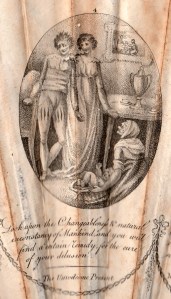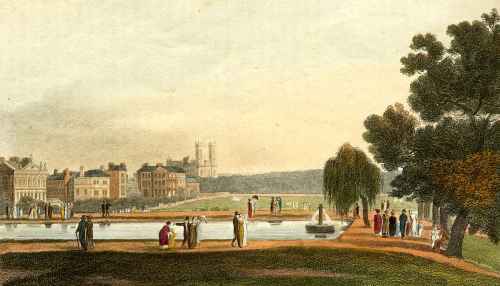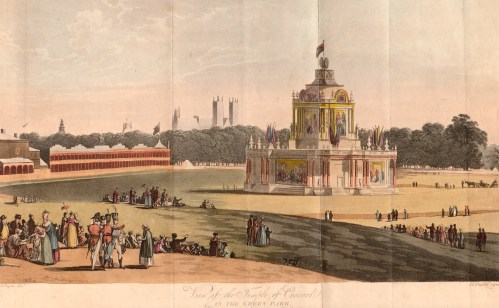The Georgian SeasideThe Earl of Wittering, his wife, son and daughter in law and grandchildren are all at the theatre, accompanied reluctantly, by Porrett the Earl’s secretary who is in the throes of a violent, whispered quarrel with his granddaughter, Emily.
‘I love you, Frederick!’ says Emily, her declaration covered in the shrieks from the stage where the melodrama put on by the touring company is reaching its climax with bodies strewn in all directions.

‘You cannot,’ he whispers miserably. ‘Look at the play – it was a wild success in Chichester.’
‘I don’t care if that is Mrs Siddons out there,’ Emily snaps. ‘Do you mean you do not love me?’
Poor Porrett – to do the honourable thing is to lie. ‘Of course I love you,’ he admits miserably. He cannot lie to his beloved even though, as a gentleman, he should. ‘And it can never be. Your grandfather is the Earl, my employer…’
‘Do not be so feeble,’ Emily says, almost in tears. ‘Tell them all how you feel, ask for my hand!’
‘No,’ says Porrett, resolute in his anguish. ‘I cannot.’ The villain stabs the hero on stage and then falls on his own sword. Porrett knows how he feels. ‘You deserve better.’
Emily makes a sound like a furious kitten and turns her shoulder to him. In the interval her father, the Viscount Ditherstone, announces his intention of taking out a pleasure boat and having a family picnic further along the coast.
‘The fishermen expect high winds tomorrow, my lord,’ Porrett, points out. ‘It might be safer to leave it for another day.’
‘Oh, don’t be such a coward,’ says Emily, nose (somewhat pink) in the air. ‘Papa knows all about sailing, don’t you Papa?’
The Viscount, who has spent two days being seasick on a friend’s yacht ten years ago, smirks ‘No need, for you to concern yourself, Porrett. My father will want you to do some work, I’ll be bound. You needn’t be nervous about getting your feet wet.’
Porrett is still smarting from Emily’s disdain the next morning and indeed, the weather looks set fair as everyone except himself and the Earl set out with picnic hampers to hire a small sailing boat. His last-minute plea to Emily to stay behind was met with a reproachful look and a muttered accusation of not having the courage to stand up to Papa for her sake.
But by midday, as he looks out of the window yet again instead of taking the Earl’s dictation , he sees the black clouds boiling up from the west. The wind is beginning to snap the flags along the promenade. ‘My lord, I have the gravest apprehension about the safety of the sailing party. I should hire a boat and go after them.’
The two men run to the harbour and Porrett hails a pair of fishermen who are just tying up. At first they refuse to take him out, but the sight of the banknotes the Earl is brandishing changes their mind. With Porrett clinging grimly to the mast they set sail. By the time they reach the stretch of coast the Viscount intended to land at for the picnic they see no sign of the boat – but then Porrett spots a slim figure on the shore waving a handkerchief. Emily! And, ‘There’s the boat, sir!’ cries a fisherman and, sure enough, mastless, the little sailing boat with a green-faced Viscount clinging to the thwarts, is just before them. They grapple it and haul him aboard – when he attempted to take the party off again in the face of the rising wind, he was washed out to sea, the mast snapped and the ladies and young Arthur were left stranded on the beach, trapped between the cliffs and the rising tide.
Porrett does not hesitate, he leaps into the fishing smack’s rowing boat, casts off and rows for shore. It is rough, dangerous and he is exhausted, but he makes it to land, runs onto the beach, helps the Viscountess and young Arthur in, then takes Emily in his arms, kisses her passionately and wades into the sea to set her gently into the little craft. He feels he could swim back, he is so elated, but he rows back to the smack and is disconcerted when the Viscountess throws her arms around his neck and kisses him, declaring that he is their saviour, their Galahad, their knight in shining armour. Emily just sits and gazes at him with tears in her eyes. When they reach the jetty the Earl, with a look on his face that promises retribution later for his feckless son and heir, hurries his womenfolk and grandson back to the lodgings. Porrett is left to trudge, wet and exhausted, behind.
He is disconcerted to discover a note commanding him to attend the ball at the Assembly Rooms that evening, wishing instead that he could just put his feet up and nurse his broken heart in decent privacy. But an order is an order. He comes down to join the family in the drawing room and, to his amazement, the Earl embraces him warmly, hails him as a hero and announces that he has secured him an influential post in the Home Office. ‘You’ll need it to keep my little Emily in the manner to which she has become accustomed,’ he announces. ‘I’ve had my eye on the pair of you and you, young Porrett, have the makings of a great man about you. More than my clodpole of a son,’ he murmurs in the stunned secretary’s ear. ‘Well, get on and ask her, don’t stand there like a looby.’
So Porrett finds his voice and, in front of the entire family, goes down on one knee and begs Emily for the honour of her hand in marriage. And Emily, throws her arms around him the moment he stands up (almost knocking him flat), bursts into tears and declares that no-one was ever such a hero as he is.
So off they go to the ball. You can see them just slipping off to the terrace (which leads to the gardens) in the far left of the picture. Sometimes Porrett is not quite such a saint as the Earl believes him to be…

Pleasure boats were an essential part of the Georgian seaside holiday, but accidents were not at all uncommon, including one Margate party who were tossed around at sea for more than 24 hours before being rescued – no mobile phones, no life jackets…
You can find out more about the perils of the seaside, the Assembly Rooms, the theatres and their travelling companies of players, or, in fact any aspect of the life of the coastal resorts before the railways came in The Georgian Seaside.
Save
Save
Save
Save
Save
Save
Save
Save











 ‘Such a pity green does not suit me.’ They wander on a little, Porrett tongue-tied with love, Emily uncharacteristically silent. Finally she blurts out, ‘You went swimming this morning.’
‘Such a pity green does not suit me.’ They wander on a little, Porrett tongue-tied with love, Emily uncharacteristically silent. Finally she blurts out, ‘You went swimming this morning.’ ‘We cannot,’ he mumbles with nothing like his normal fluency. ‘You are the granddaughter of an earl. I am…’
‘We cannot,’ he mumbles with nothing like his normal fluency. ‘You are the granddaughter of an earl. I am…’



